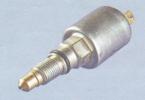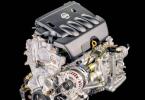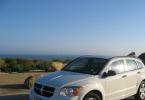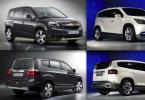The world's oldest manufacturer of trucks (since 1896) and diesel vehicles (since 1924) Daimler-Chrysler AG has existed in its current form since 1998. Then the German concern Daimler-Benz AG (since 1926) took over the third largest American manufacturer Chrysler Motors (since 1924), creating the fourth largest transnational concern in the world. DC is the third largest truck manufacturer in the world. The largest German automotive division produces all types of trucks and commercial vehicles from 2.7 to 33 tons gross vehicle weight.

The first half of the 90s was marked by the struggle to reduce the toxicity of exhaust gases and the preparation of fundamentally new trucks. Models of the light series “T2” (“609/814”) and the new medium range “LK” (“711/1517”), having received “clean” diesels with a capacity of 105-170 “horses”, became known as “Ecovan” and Ecoliner respectively. Heavy series "MK" and "SK" (models "1417/3553") were produced in 55 basic versions (4 × 2/8 × 8 with engines with a capacity of 165-530 "horses", with six types of cabins. Since 1992, on saddle The SK1844 / 1944LS tractors were equipped with a more spacious and comfortable Eurocab cab with an internal height of 2110 millimeters.

Since the mid-1990s, Mercedes-Benz has begun a complete replacement of its entire European program. At the beginning of 1996, the MB100 series was replaced by a front-wheel drive Vito range with a total weight of 2.6 tons (108D / 114 models) with transverse engines of 79-143 horses. In January 1995, at the Brussels Motor Show, the Sprinter delivery vehicles of the new light TIN range were presented, which were awarded the Van of the Year title. By 2001, it consisted of several dozen variants from “208D” to “616CDJ” (79-156 hp) with bodies with a capacity of 7-13.4 m3.

The "T2" series in 1997 was replaced by the "Vario" range with a total weight of up to 7.5 tons (models "512D / 815D") with low-emission diesel engines of 115-136 "horses", disc brakes and ABS. The title “Truck of 1997” was awarded to the new heavy range “SKN” or “Actros”, consisting of targets “1831/4157” with V6 and V8 engines (313-571 hp) with electronic control, air suspension, disc brakes, ABS and ASR, three types of cabins with an internal height of up to 1960 mm. In 1999, the title “Truck of the Year” was awarded to the Atego car of a new medium range (models “712/2628”) with engines of 122-280 “horses” and 14 wheelbase sizes.

In 1998, the NAV plant began manufacturing the Econik low-frame chassis with a 4-seater cab, diesel or gas engines, an automatic transmission and an electronically controlled air suspension. At the end of the 20th century, Mercedes-Benz remained the world's largest manufacturer of commercial vehicles. It owns 14 factories in Germany and 25 factories around the world. The annual production volume exceeds 420 thousand vehicles. On May 7, 1998, Daimler-Benz strengthened its position by merging with the American Chrysler Corporation and creating a new transnational concern Daimler Chrysler.
(Western Star). In the 21st century, its staff reached 273,216 people (as of December 31, 2008), and its total income was 1.4 billion Euros (2008).
©. Photos are taken from publicly available sources.
The Mercedes company is a company that is a leader not only in the European markets, but also around the world. It has established itself as a reliable and stable manufacturer of good and high-quality equipment, including trucks, during the use of which everyone who purchased it is satisfied. The company, which was founded back in 1926, has now achieved global recognition and increased the multiple variety of its technology. At the same time, the number of satisfied people and customers is growing, and Mercedes cars win the hearts of thousands of people every day and their number is steadily growing every day.
Characteristics of trucks of this brand
A huge range of trucks is worthy of attention, because it is they who are distinguished by their excellent performance and reliability on the road. I would also like to note the technical characteristics of Mercedes trucks, since there are almost no equal to them in this regard, and everyone who bought them was convinced of this. The modern, sophisticated design also cannot be ignored. The Mercedes company has focused not only on technical characteristics, but also on the appearance of its models, which is noticeable at first glance.
Actros - European long-haul tractor
Among the series of models of Mercedes trucks, the new Actros can be distinguished, which proved to be excellent in especially difficult working conditions. It will not be difficult for him to transport a large load, in terrible weather conditions, over long distances. The truck is also equipped with a sixteen-speed gearbox, and 8 types of V6 and V8 engines, the power of which varies in the range of 320 - 578 horsepower, from which we can conclude that it is capable of really impressive cargo transportation.
It is also worthy of attention that Mercedes trucks are capable of transporting impressively large loads, in addition, they are able to overcome country roads, which the buyer really likes.
If we talk in more detail about the technical characteristics, then it is necessary to highlight the high safety that is inherent in the machines of this particular brand. This has been proven by numerous tests carried out to continuously improve safe driving. The most comfortable driving conditions were created for the drivers. The cabins of trucks are made according to the latest technologies, which are distinguished by high functionality. This makes it possible to simplify the driver's work and significantly increase the comfortable stay inside at any time of the year, and in any weather. At the same time, its multifunctionality is expressed in its ease of use and long-term trouble-free operation. In order to identify the most practical and at the same time pleasing cab design, many studies and tests were carried out, during which it was shown that drivers were more comfortable behind the wheel of Mercedes-Benz trucks than others.
 Click to enlarge
Click to enlarge
Unimog - a technique with unique capabilities

Technical characteristics of the car:
- Power hydraulics VarioPower;
- Bi-directional steering VarioPilot;
- Fast gear shifting Telligent;
- U-shaped bridges for greater ground clearance;
- All-wheel drive and limited slip differential.
The car is completely safe on the road. Easy to operate, comfortable and dynamic. It handles like a passenger car, making it a joy to drive.
 Click to enlarge
Click to enlarge
Convenience and comfort are the main quality criteria Atego

The manufacturer also took care of the economy of these machines. During the development of new parts, the most productive parts were created, while using the least amount of fuel. For example, the machine engine has been improved, which now has maximum wear resistance. This also applies to the rest of the details, since the manufacturer makes sure that as little money as possible is spent on repairing the Atego, and at the same time its functionality is increased. That is, now much less money will be used to repair or replace parts, and this is not the limit for the development of the Mercedes concern. Thus, we get a high level of comfort when using Atego, and an excellent solution with a minimum cost of car maintenance and repairs.
 Click to enlarge
Click to enlarge
Technical data for Axor trucks
At the moment, many manufacturers are interested in ensuring that their transport does as little harm to the environment as possible with their work. The Mercedes company not only did not bypass this issue, but also succeeded in solving it. A lot of efforts have been made to reduce environmental pollution, a purification system has been created that deals with the cleaning of exhaust gases, which has a positive effect on the environment.
You will never hear complaints from people using Mercedes trucks that they do not work well in difficult climates. After all, the company strives to make equipment not only for a specific climatic zone, since it supplies cars all over the world, and makes it comfortable to use for everyone, anywhere in the world.
Mercedes-Benz is a German company specializing in the production of passenger cars and engines, founded in 1926. Currently, it is a subsidiary of the Daimler-Benz concern. The headquarters are located in Stuttgart.
After the death of Gottlieb Daimler in 1900, his son Paul and engineer Maybach continued the car manufacturing business. Wilhelm Maybach, a loyal assistant to Gottlieb Daimler, took over the entire management of the company. In 1900, he began to develop a new car. It had a classic arrangement of parts - the engine and radiator were located in front under the hood, the drive was carried out through a gear transmission to the rear wheels. The new car was powered by a 35 hp 4-cylinder engine. The first sample was made in the form of a two-seater racing car The model was named Mercedes, in honor of the daughter of one of the co-owners of the company - Austrian entrepreneur, diplomat and avid race car driver Emil Jellinek. On this car with an improved design, Jellinek won a victory at regular races in March 1899, glorifying the Daimler company and the name Mercedes all over the world. Since that time, all Daimler cars have been produced under the Mercedes brand. The very first Mercedes served as the basis for the creation of a more advanced Mercedes Simplex, which opened the era of the most powerful and comfortable cars of this brand.
Daimler decided to use an apt name and registered this name. as a trademark. in 1902. And for the personally built car of Mr. Emil Jelinek was given its own name: "Emile Jelinek-Mercedes".
In 1921, Mercedes was an innovator in the production of supercharged cars, and in 1923 it relied on a model with a six-liter engine, which became the base for the modification with a short-wheelbase chassis - Model K, and then Model S. On its basis, a new modification was created - the Mercedes Model SS , with a 7-liter supercharged engine with a capacity of 200 hp.
During this time, the most prominent engineers who created the name for the "Deimler-Benz" concern were Ferdinand Porsche, Fritz Nallinger and Hans Niebel.
The first production cars were equipped with a high-power engine capable of developing up to 140 hp when the supercharger was turned on, then the displacement of this engine was increased to 7 liters, which served as the starting point for the creation of the "SSK" sports car with a 170/125 hp engine. with .. and the speed limit of such models has already reached about 160 km / h. The next step was an improved and shortened version of the "SSKL" with a 300 hp engine. - the undisputed favorite of numerous sports competitions of those years.
In 1926, "Deimler Geselschaft" and "Benz und Co" began to negotiate a merger, and the result of their union was a three-pointed star, symbolizing the three elements subject to the concern's machines - air, water and earth. This official emblem of the Sr. Daimler company became common for the new concern, and the cars were delivered to the market under the Mercedes-Benz trademark.
So, by the 1930s, Mercedes-Benz had established itself as a designer and manufacturer of luxury cars when Hans Niebel produced the "770 Grosser". Under the hood of this giant hid a 7.7-liter supercharged engine, so the super-powerful car for that time was in special demand among high-ranking customers, including ex-Kaiser Wilhelm II and the Emperor of Japan Hirohito, and the next modification of the car, launched into production only in 1938-1939 years, was intended exclusively for the top of the "Third Reich". It presented a modernized engine from the "770 Grosser" model, which developed with the included compressor power of 230 hp. plus a novelty of the concern - a completely new tubular frame, as well as independent front and rear suspensions, which have been tested on racing cars. The ordinary consumer was offered a rather cheap model "Type-170", with a tubular frame, independent front and rear suspensions, the production of which began in 1931.
A few years later, the concern began to produce the first diesel passenger cars, offering customers the 2.6-liter Type-260 D, and the design team led by Porsche was already preparing for production the rear-engined models: 130 N, 150 N and 170 N. , which were of great interest (about 90,000 of these cars were produced until 1942) - a huge figure for the automotive market at that time.
In the early 1940s, the demand for luxury, powerful Mercedes cars increased sharply in Germany. They were produced on special orders for the heads of state and government, high-ranking Nazis, as well as those for whom traditional cars did not seem ambitious enough, the whole Mercedes-Benz plant in Stuttgart.
After World War II, Mercedes returned to motorsport and even won the 1952 24 Hours of Le Mans. In 1963, the 600 model was released, which, in the opinion of its manufacturers, was supposed to compete with Rolls-Royce in the automotive market.
Mercedes G – class is a series of off-road vehicles. A small demand for these rather expensive cars, which are distinguished by enviable durability and maneuverability, will lead to a relative constancy of the design and a minimum of changes. The new generation is presented in Paris in September 2000.
When in November 1979 a new generation of large sedans of the representative S-class (factory body index W126) of the Daimler-Benz automobile concern was presented to the public, it was already announced that they would become the best cars of the 1980s. And it turned out to be true. In May 1991, the company officially announced the discontinuation of the W126 range.
In the 1980s, Japanese firms began to set the tone for the luxury car market. However, European automakers bravely took the fight: an example of this is the latest Mercedes S-class models in their 12-cylinder version, which have confirmed the high competitiveness of German technology. The famous Mercedes 600S has superpower and reliability, is capable of sharp turns, despite its size, and has many other excellent characteristics, therefore it is he who is considered to be the best car produced by this company today.
Mercedes CL C215 is a luxury car with a coupe body. The model of the 126 series was first introduced back in 1981, the 140 series in 1992 (platform type C215). In 1999, the lineup was replenished with new modifications - CL 600 and CL55AMG.
With the introduction of Model 190 (body serial number W201) in November 1982, Mercedes-Benz took the lead in prestige in the European segment of D-class cars. In September 1983, the long-awaited model 190D premiered, which immediately became popular with taxi drivers. In May 1993, at the Daimler-Benz plant in Bremen, the model from the W201 body was changed to the C-class (W202) sedans.
Mercedes E – class, a series of cars of the upper middle class. First shown in 1984. A new generation appeared in 1995. In Frankfurt in 1997, a modification of the E 55 AMG and a V8 engine was introduced. Since 2000, the models have been equipped with 270 CDI and 320 CDI engines.
The most popular Mercedes-Benz of all time was the series with the factory body index W124. In total, over 2.7 million copies were produced in eleven years. The W124 four-door sedan lineup was introduced in November 1984 in seven engine modifications.
Mercedes SL is a luxury sports car with a roadster body with a removable roof. The model was first presented in Geneva in 1989. In 1992 the model range was replenished with a new modification - the SL600. In the spring of 2001, a new generation of these machines appeared.
The debut of the S-class - W140 in Geneva in 1991 made a splash. "Super" S-klasse! The W140 was second to none in terms of size, luxury and capacity, as well as the quality of the materials used. The production of the much-loved "elephant" was stopped in the second half of 1998, replacing it with the newest, more compact (at least externally) S-klasse with a W220 body.
For the first time, the Mercedes C series, a middle-class car (sedan), was shown in April 1993. Since autumn 1995 it is equipped with a compressor, since June 1997 - with 2.4l and 2.8V6 engines. A new generation of models appeared in the spring of 2000.
The new C-Class Sport Coupe, powered by a newly developed 2-liter compressor engine, is one of the most dynamic cars in this segment.
The second generation of small Mercedes-Benz called C-klasse (body of the factory series W202) was born in April 1993. In the winter of 1996, in the W202 family, the four-door sedan was supplemented with a five-door Touring station wagon (abbreviated as T).
The Mercedes-Benz SLK, a two-seater folding roof roadster, was first presented in April 1996 in Turin. In January 2000, a model appeared with an updated design and a 3.0-V6 engine. The car has received more than 35 international prizes and awards, including: "Golden Steering Wheel" (Germany, 1996), "Most Beautiful Car in the World" (Italy, 1996), "Car of the Year" (USA, 1997), "Best Convertible in the World" (Germany, 1998), "Most Popular Convertible" (Italy, 1999).
The Vito family of trucks (Mercedes-Benz V - class) in 1996 won the title of the best van of the year. The Sprinter family includes 9 basic models and 137 modifications. The main body types are: all-metal and cargo-passenger vans, as well as a minibus with 15 seats.
The Mercedes ML combines the essential characteristics of an SUV, a minivan, a station wagon and a passenger car in a multi-purpose vehicle. A family of off-road vehicles with permanent all-wheel drive are manufactured in the USA. The model was first introduced in 1997. The M-class delivery program for Europe includes three model variants: base ML 230; 6-cylinder model ML 320 and 8-cylinder version ML 430. In 2000, these cars did not change, but the model range was supplemented by two new basic versions - diesel ML270 CDI and tuning ML55 AMG.
Since October 1997, the Mercedes-Benz A-class compact car family has been successfully sold. In 2000, this family remained practically unchanged.
Mercedes-Benz CLK is a family of cars with coupe and convertible bodies of an intermediate class between C and E, created on the basis of class C. For the first time the CLK model with a coupe was shown in the winter of 1997 in Detroit. In 1998 a convertible was added to the model range, and in the summer of 1999 the design of the cars was updated.
The Mercedes-Benz CLK-GTR is a unique road version of the Grand Turismo GTR racing car. Limited edition production (25 pcs.). The first performance was November 1998.
In an effort to expand the range of products, the company launched a completely new car - the Smart subcompact.
1998 - Merger of Daimler-Benz AG and Chrysler Corporation.
The Mercedes Vision SLR Roadster Concept, a two-seater sports car, was first introduced in Detroit in July 1999. The model is used in Formula 1 racing.
Mercedes Vision SLA Concept, a compact class roadster. Introduced as a concept model at the 2000 Geneva Motor Show.
Mercedes-Benz is still at the pinnacle of the automotive industry as it was 100 years ago. By making high-quality cars and engines, the stellar concern with the famous brand in the form of a three-pointed star has consistently maintained a leading position in the automotive industry and a high competitiveness for a century.
Brand Mercedes perhaps one of the oldest in the world. Mercedes-Benz trucks began to be produced at the dawn of the 20th century. And it owes its name to Karl Benz, who is the author of the development of the oldest car, and Gottlieb Daimler, who produced the first 4-wheeled car.
Today the Mercedes concern produces the widest range of automotive equipment. And first of all, these are trucks. The Mercedes lineup includes truck tractors, chassis vehicles and dump trucks. Mercedes semitrailer tractors are designed for towing various types of semi-trailers (from vans to tanks and platforms for the transportation of oversized cargo). Cabs of Mercedes trucks are adapted for comfortable work of the driver on a long journey.
The safety of drivers, goods and the truck itself is ensured by disc brakes and ABS. All Mercedes tractors are equipped with underrun bars that prevent cars from entering the space between the rear axle and the semi-trailer chassis. These Mercedes models (truck tractors) can carry loads of up to 40 tons.
In the Mercedes lineup there is another line of trucks - dump trucks. The technical characteristics of this type of technology (powerful power unit, solid construction, easy handling and stable movement) provide Mercedes models with the most important performance qualities - power and endurance. The power of the power units of Mercedes dump trucks reaches 408 horsepower. Also trucks Mercedes equipped with on-board electronics. The electrical control system with which the power unit is equipped is designed for operational data processing and coordination of the actions of all systems.



